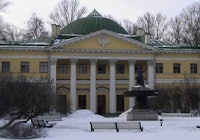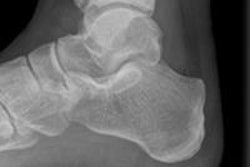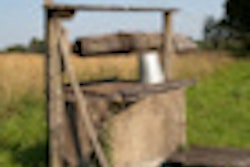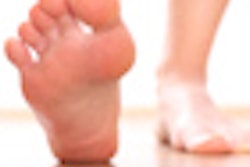
The most common pathologic changes occurring in acute ankle inversion trauma are tears to the anterior talofibular and calcaneofibular ligaments, followed by injuries to the sinus tarsi structures and tears to the peroneus longus and brevis tendons, according to a study conducted at a top Russian military hospital.
"Due to numerous combinations of movements in a moment of ankle inversion trauma, different types of injuries can develop," noted lead presenter Dr. I.S. Pashnikova, from the department of radiology, Kirov Military Medical Academy, St. Petersburg, in an e-poster at this month's European Society of MR in Medicine and Biology (ESMRMB) congress in Lisbon. "MRI is the useful modality that can assess both soft-tissue and osseous pathologic changes in acute inversion trauma."
The researchers sought to throw new light on the pattern of injuries in acute ankle inversion trauma and show relations between these injured structures. They conducted an analysis of complex clinical, radiographic, and MRI investigations of 76 patients with acute inversion trauma (47 men, 29 women, average age 39.7 years). All patients went through routine ankle radiography to rule out fracture.
 |
| The Kirov Military Medical Academy may be converted into a faculty of medicine within St. Petersburg State University. Image courtesy of Naval Today. |
MRI was performed on 1.5-tesla scanners, using routine imaging protocols that included five basic sequences: sagittal T1-weighted images (TR 427 ms, TE 13 ms, averages 2, matrix 320x256, slice thickness 3 mm, dist. factor 0, FOV 16x16 cm); sagittal PD-weighted images with fat saturation (TR 2700 ms, TE 15 ms, averages 2, matrix 320x256, slice thickness 3 mm, dist. factor 0, FOV 16x16 cm); axial PD-weighted images with fat saturation (TR 3930 ms, TE 15 ms, averages 2, matrix 384x192, slice thickness 2.5 mm, dist. factor 0, FOV 10x19.9 cm); coronal PD-weighted images with fat saturation (TR 4150 ms, TE 21 ms, averages 2, matrix 320x134, slice thickness 2.5 mm, dist. factor 0, FOV 9.2x16.4 cm); and oblique coronal 3D-CISS (constructive interference in steady state sequence) images (TR 12.8 ms, TE 6.4 ms, averages 2, matrix 384x208, slice thickness 1.2 mm, dist. factor 20, FOV 9.8x18 cm).
The MR images were then analyzed by two musculoskeletal radiologists in consensus.
The pathologic findings on MRI were: anterior talofibular ligament (ATFL) tear = 63 (83%) (partial = 34, complete = 29); calcaneofibular ligament (CFL) tear = 54 (71%) (partial = 35, complete = 19); posterior talofibular ligament partial tear = 4 (5%); deltoid ligament partial tear =15 (20%); peroneus brevis tendon partial tear = 29 (38%); peroneus longus tendon partial tear = 40 (53%); peroneus tertius tendon tear = 7 (9%) (partial = 5, complete = 2); injury of sinus tarsi structures =46 (61%); osteochondral lesions of the talar dome =11 (14.5%); anterior process calcaneus fracture = 3 (6%); and fifth metatarsal tuberosity avulsion fracture =1 (1%).
In 58 cases, associated injures of several structures were revealed. There were associated tears of ATFL and CFL in at least 21 cases. CFL tears were associated with the injury of sinus tarsi structures in at least 32 cases, and with peroneal tendon tears in at least 36 cases. All cases of osteochondral lesions and fractures of the anterior process calcaneus were associated with the ATFL tear.
"Thus, the most frequent pathological findings in patients with acute ankle inversion trauma were associated lateral complex ligament (ATFL and/or CFL) tears, peroneal tendons -- peroneus longus, peroneus brevis, peroneus tertius tendons -- tears and injuries of sinus tarsi structures (inflammation of sinus tarsal fat tissue and alteration in the structure of sinus tarsi ligaments) in different combinations," the authors stated.
Established in 1798, the Kirov Military Medical Academy trains senior medical staff for the armed forces and conducts research in the medical services area for the military. It is a full-scale medical school with a network of teaching and research clinics and hospitals affiliated with it. A proposal to convert the academy into a faculty of medicine within St. Petersburg State University reportedly is under consideration, but this would involve moving to a new location.



















